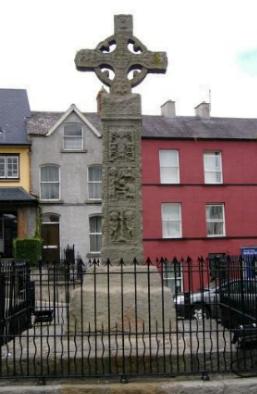|
|
|
| |
Castleblaney. |
||
| (Castle of the Blaney's.) This town derives its name from Sir Edward Blaney who was appointed governor of the area in 1604. Just outside the town is Hope Lake which covers an area of 900 acres, it is the largest lake. The lake is open all year for fishing, competitions are held each year attracting competitors from far and wide. Hope Castle is situated near the lake affords fine views of the surrounding countryside. Also on the shores of the lake is Castleblaney Golf Course Other activities available in the locality are water-skiing and wake boarding at Lough Muckno Water-ski club. The Black Islands and Concra Wood provide opportunities for scenic walking. Two pitch and putt centres are available in the area one at Malone's in Muldrommond, and rowan Springs in Doohamlet. Try your hand at clay pigeon shooting in the Lough Egish area. Bowl's enthusiasts are catered for at Blaney Bowls on the Monaghan road. |
||
|
|
Clones. |
||
| (Eo's meadow.) The town of Clones is set amid the The Ulster Canal Store located in Cara street is the local Tourist information centre, you will find information on the many heritage and historical sites in the area, guided yours can be arranged. The building also incorporates the Clones Lace Gallery where a fine display of locally made lace is on display. The substantial remains of a round tower 23 Metres (75 Ft) high stands in an ancient graveyard, just off Cara street on Ball Alley Lane. In this graveyard are some interesting headstones, they have the usual inscriptions most of which are illegibly, but the reverse side is carved with symbols which are most likely Masonic. See Round Tower's. |
||
|
|
Ballybay. |
||
| (Ford mouth of the birch tree.) The town of Ballybay lies on the shores of Lough Major, this 200 acre lake is drained by the Dromore river, which flows through a valley forming a series of smaller lakes, each and the river itself affording many opportunities for some excellent coarse fishing. Ballybay grew up in the middle of the eighteenth century when the linen industry was in its infancy in Ireland. This came about partly because of the Huguenot expulsions from France, these people settled in various countries, and brought with them their knowledge of growing and processing flax. The linen industry remained a significant contributor to the Irish economy until the middle years of the last century. |
||
|
|
Clontibret. |
||
| (Meadow of the well.) This peaceful village set in mid County Monaghan
was in 1595 the scene of a famous battle between Hugh
O'Neill Earl of Tyrone and Sir Henry Bagnell, O'Neill's brother in
law. On the information board in the village there is details of this
battle. Later in 1598 the two met in battle again at Yellow Ford near
Blackwatertown, County Armagh, Bagnell's army was defeated and he slain.
The Wildlife Centre located in the area offers a unique insight into the flora and fauna of Monaghan, and is well worth a visit. Read about Clontibret in 1837 |
||
|
|
Inniskeen. |
||
| (Beautiful island.) One of Ireland's most famous literary figures was born in Inniskeen in 1904. the Patrick Kavanagh Rural and Literary Resource Centre is located in the church which he attended as a boy. Kavanagh died in 1967 and is buried in the church yard beside the centre. In the center is the Poet's rest coffee shop and a 1920's style kitchen. Click for more information about Patrick Kavanagh. The river Fane wends its way through Inniskeen, along this are pleasant walks and many opportunities for a spot of fishing. The pitch and putt course is situated close to the river. In the locality is a round tower and motte and bailey. In an area known as the Deerpark is an interesting geological feature where over one hundred different specimens of rock have been identified. |
||
|
|
